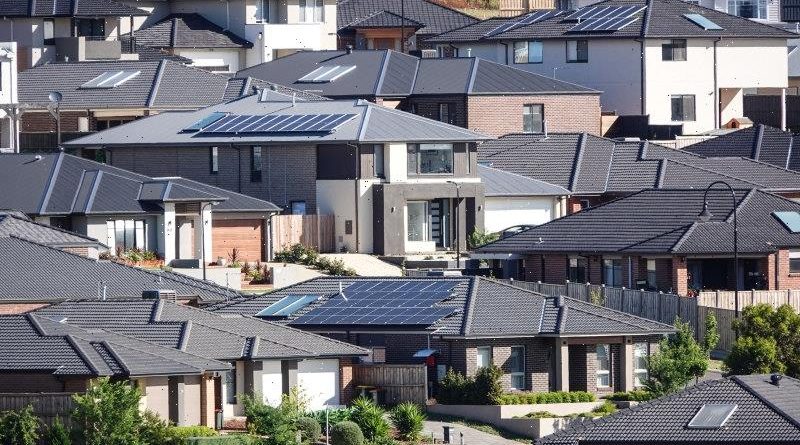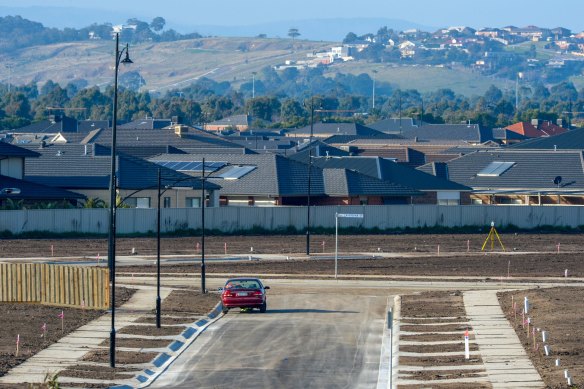The suburbs that will suffer most from Melbourne’s planning failure
Two authors of the blueprint guiding Melbourne’s expansion over the next three decades say more Victorians will be cut off from jobs and services because the government is failing to redirect population growth away from the city’s outer fringe and towards middle suburbs.
Melbourne was forecast before the COVID-19 pandemic to grow to 9 million people by around 2050 — the size of London today — and voters who spoke to The Age as part of its Victoria’s Agenda project said dealing with that growth was one of their top concerns ahead of the November state election.
A new housing estate off Cardinia Road, next to the Pakenham bypass.Credit:Penny Stephens
Containing 70 per cent of new housing to established suburbs — where residents will be close to existing services, jobs and public transport — by 2050 was a key goal set by Plan Melbourne, a government strategy first released in 2014 and updated in 2017.
But new “greenfield” housing developments in the outer cities of Casey, Cardinia, Hume, Mitchell, Melton, Whittlesea and Wyndham made up 56 per cent of the new dwellings built in 2021 and 52 per cent in 2020, according to data from the Department of Environment, Land, Water and Planning.
Professor Roz Hanson, who chaired the Plan Melbourne’s Ministerial Advisory Committee, and John Stanley, a member of that committee, said they were concerned the government was not doing enough to encourage denser residential development in middle suburbs.
“We just cannot keep carving up vacant land out on the edge of metro Melbourne,” said Hanson, a professorial fellow at the University of Melbourne’s Faculty of Architecture, Building and Planning.
“The long-term effects are that we’re going to have more people living in urban areas without access to sufficient jobs and services — it’s this concept of the haves and the have-nots in Melbourne.”
Hanson said slowing growth in outer suburbs, and encouraging greater density where it did occur, should be the top priority when the government reviews Plan Melbourne next year.
The key opportunity was to encourage denser populations in middle suburbs, where there are already jobs and public transport but not enough housing, she said.
DELWP data shows that close to half the dwellings built in established suburbs were in three inner-city council areas — Melbourne, Yarra and Port Phillip — meaning all other established areas accounted for only a quarter of new dwellings in 2021 and 30 per cent in 2020.
Stanley, an adjunct professor at the University of Melbourne’s Institute of Transport and Logistics Studies, agreed that medium-density redevelopment in middle suburbs was not happening “anywhere near quickly enough”.
“There are considerable failures in execution and implementation in delivering the kind of city that we envisaged,” he said.
Planning Minister Lizzie Blandthorn said in a statement that the Andrews government was committed to Plan Melbourne’s long-term goals, including limiting greenfield development.
The government was delivering Plan Melbourne’s concept of “20-minute neighbourhoods” in new precincts like Arden (in North Melbourne) and Fisherman’s Bend (Port Melbourne), and as part of the governments’ flagship Suburban Rail Loop, she said.
The Suburban Rail Loop’s first $34.5 billion leg includes higher-density housing and development in six new station “precincts” between Cheltenham and Box Hill, which Labor says it will build by 2035 if it stays in office.
“We’re prioritising access to housing in suburbs with established infrastructure, services and jobs — so Victorians can work, exercise and socialise close to home,” Blandthorn said.
But Stanley said money would be better spent building up these areas first, and only building the loop when they reach a population and employment density that could support such a project.
Jonathan Spear, chief executive of the independent government advisor Infrastructure Victoria, said the state risked sacrificing liveability and sustainability if it did not do more to redirect its population growth away from outer suburbs.
“That includes prioritising locations in established suburbs for more housing to better use existing infrastructure,” Spear said. “If we pile the pressure on our growth areas in the coming decades, it’s going to be harder to meet their infrastructure needs.”
Infrastructure Victoria has previously warned that it costs two to four times more to build transport, services and utilities for new housing in greenfield suburbs than in established areas.
The Morning Edition newsletter is our guide to the day’s most important and interesting stories, analysis and insights. Sign up here.
Most Viewed in National
From our partners
Source: Read Full Article



